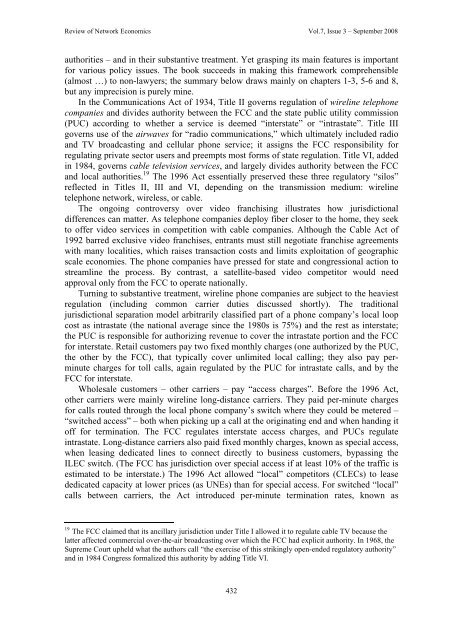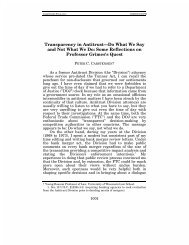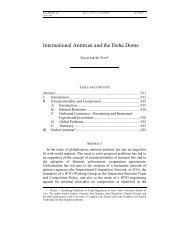An Essay Review of Nuechterlein and Weiser's Digital Crossroads
An Essay Review of Nuechterlein and Weiser's Digital Crossroads
An Essay Review of Nuechterlein and Weiser's Digital Crossroads
- No tags were found...
You also want an ePaper? Increase the reach of your titles
YUMPU automatically turns print PDFs into web optimized ePapers that Google loves.
<strong>Review</strong> <strong>of</strong> Network Economics Vol.7, Issue 3 – September 2008<br />
authorities – <strong>and</strong> in their substantive treatment. Yet grasping its main features is important<br />
for various policy issues. The book succeeds in making this framework comprehensible<br />
(almost …) to non-lawyers; the summary below draws mainly on chapters 1-3, 5-6 <strong>and</strong> 8,<br />
but any imprecision is purely mine.<br />
In the Communications Act <strong>of</strong> 1934, Title II governs regulation <strong>of</strong> wireline telephone<br />
companies <strong>and</strong> divides authority between the FCC <strong>and</strong> the state public utility commission<br />
(PUC) according to whether a service is deemed “interstate” or “intrastate”. Title III<br />
governs use <strong>of</strong> the airwaves for “radio communications,” which ultimately included radio<br />
<strong>and</strong> TV broadcasting <strong>and</strong> cellular phone service; it assigns the FCC responsibility for<br />
regulating private sector users <strong>and</strong> preempts most forms <strong>of</strong> state regulation. Title VI, added<br />
in 1984, governs cable television services, <strong>and</strong> largely divides authority between the FCC<br />
<strong>and</strong> local authorities. 19 The 1996 Act essentially preserved these three regulatory “silos”<br />
reflected in Titles II, III <strong>and</strong> VI, depending on the transmission medium: wireline<br />
telephone network, wireless, or cable.<br />
The ongoing controversy over video franchising illustrates how jurisdictional<br />
differences can matter. As telephone companies deploy fiber closer to the home, they seek<br />
to <strong>of</strong>fer video services in competition with cable companies. Although the Cable Act <strong>of</strong><br />
1992 barred exclusive video franchises, entrants must still negotiate franchise agreements<br />
with many localities, which raises transaction costs <strong>and</strong> limits exploitation <strong>of</strong> geographic<br />
scale economies. The phone companies have pressed for state <strong>and</strong> congressional action to<br />
streamline the process. By contrast, a satellite-based video competitor would need<br />
approval only from the FCC to operate nationally.<br />
Turning to substantive treatment, wireline phone companies are subject to the heaviest<br />
regulation (including common carrier duties discussed shortly). The traditional<br />
jurisdictional separation model arbitrarily classified part <strong>of</strong> a phone company’s local loop<br />
cost as intrastate (the national average since the 1980s is 75%) <strong>and</strong> the rest as interstate;<br />
the PUC is responsible for authorizing revenue to cover the intrastate portion <strong>and</strong> the FCC<br />
for interstate. Retail customers pay two fixed monthly charges (one authorized by the PUC,<br />
the other by the FCC), that typically cover unlimited local calling; they also pay perminute<br />
charges for toll calls, again regulated by the PUC for intrastate calls, <strong>and</strong> by the<br />
FCC for interstate.<br />
Wholesale customers – other carriers – pay “access charges”. Before the 1996 Act,<br />
other carriers were mainly wireline long-distance carriers. They paid per-minute charges<br />
for calls routed through the local phone company’s switch where they could be metered –<br />
“switched access” – both when picking up a call at the originating end <strong>and</strong> when h<strong>and</strong>ing it<br />
<strong>of</strong>f for termination. The FCC regulates interstate access charges, <strong>and</strong> PUCs regulate<br />
intrastate. Long-distance carriers also paid fixed monthly charges, known as special access,<br />
when leasing dedicated lines to connect directly to business customers, bypassing the<br />
ILEC switch. (The FCC has jurisdiction over special access if at least 10% <strong>of</strong> the traffic is<br />
estimated to be interstate.) The 1996 Act allowed “local” competitors (CLECs) to lease<br />
dedicated capacity at lower prices (as UNEs) than for special access. For switched “local”<br />
calls between carriers, the Act introduced per-minute termination rates, known as<br />
19<br />
The FCC claimed that its ancillary jurisdiction under Title I allowed it to regulate cable TV because the<br />
latter affected commercial over-the-air broadcasting over which the FCC had explicit authority. In 1968, the<br />
Supreme Court upheld what the authors call “the exercise <strong>of</strong> this strikingly open-ended regulatory authority”<br />
<strong>and</strong> in 1984 Congress formalized this authority by adding Title VI.<br />
432





